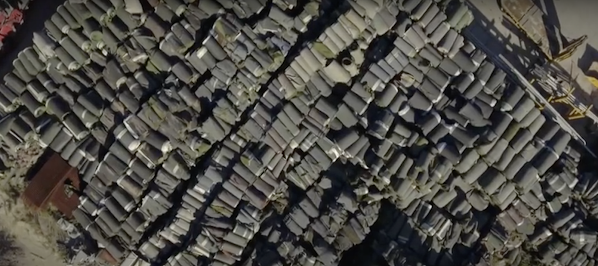Marketing artificial turf as "recyclable" is greenwashing. Being "recyclable" and being "recycled" are not the same thing.
Artificial turf is classified as a single-use plastic.
While some single-use plastic water bottles may be recycled, artificial turf is NOT being recycled in the U.S. It's challenging to separate the infill and contaminants from the carpet. There are no facilities in the U.S. that recycle artificial turf, and it's unlikely we're shipping it overseas.
Industry confirms in the video below that no artificial turf has EVER been recycled in the U.S.:
So what assurance is there that the artificial turf components will be recycled when our kids are done with them (which is presumed to be 8-10 years from install) even if the school district has a contract for such a service? Why shouldn't we be concerned that the components will be left to rot somewhere? Where are the facilities that recycle this stuff? What products are they turning it into? Does anyone follow up on these customer contracts?
There's valid reason to be concerned...
The video "What happens to plastic and polluting artificial turf?" gives reason to be concerned that the components may ultimately wind up left rotting somewhere. It shows the story of big businesses in Holland that accept money from customers to recycle turf but instead let it illegally pile up on their properties and illegally transport it to other properties, some even out of the country.
An image from the above video shows literal mountains of plastic turf carpets accumulating.
An aerial view from the video of just one of the sites where plastic turf carpets go to die puts the scale of this problem in perspective.
LGUSD, do we really want to be part of contributing to this massive problem every 8 years?
Municipalities where these businesses have properties negotiate with the companies, give warnings, sometimes provide additional subsidies, all to try to encourage these businesses to deal with the growing literal mountain of a problem, but it's not working. The businesses cite misunderstandings and increased volumes of product coming in. Municipalities are reluctant to impose or enforce fines, interrupt the activities of these businesses, or shut them down because these are major players in the waste industry and interference could "jeopardize the continuity of the waste process", a process which is of "social importance". And understandably, municipalities fear they'd inherit the problem and expense of dealing with that massive amount of waste and don't know what to do with it.
Recycling artificial turf is not a cheap, easy process. It requires separating the infill from the carpet. The infill is contaminated with heavy metals and microplastics. Meanwhile as the mats pile up, it's dangerous for the employees that work there, a fire hazard, and in violation of environmental permits.
This 2019 article, "Fields of Waste: Artificial Turf, Touted as Recycling Fix for Millions of Scrap Tires, Becomes Mounting Disposal Mess", explains that these problems don't go away... They just become someone else's problems, BIG problems...
An attorney interviewed for the article raises the point that "Most people give little thought to the sheer weight and volume of refuse involved in disposal of used playing fields. You think about the effort you go through to recycle a week’s worth of plastic bottles and plastic bags, and you’re talking millions upon millions of that for a single field. It’s staggering.”
Even if the turf is repurposed or reused by somebody else when it's no longer good enough for our kids, that secondhand use is just a detour. I imagine the landfills and illegal dumping sites where turf components come to rest are "not in our backyard". Out of sight, out of mind. I wonder about the less-acknowledged equity issues involved in who is impacted where this waste ultimately ends up.
These issues make up some of the "externalized costs" of artificial turf. These are not costs that will appear on the expense records of the school district.
Externalized costs are an oft-ignored factor in evaluating whether artificial turf is "cost-effective".


